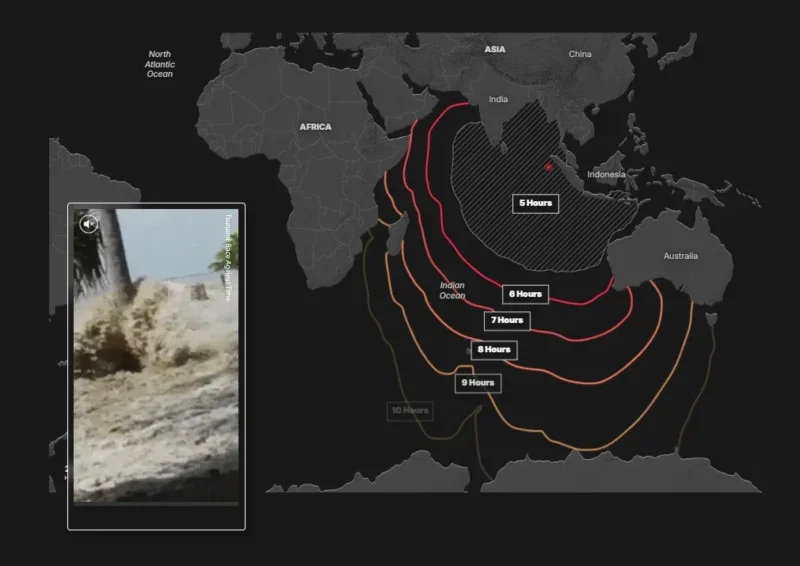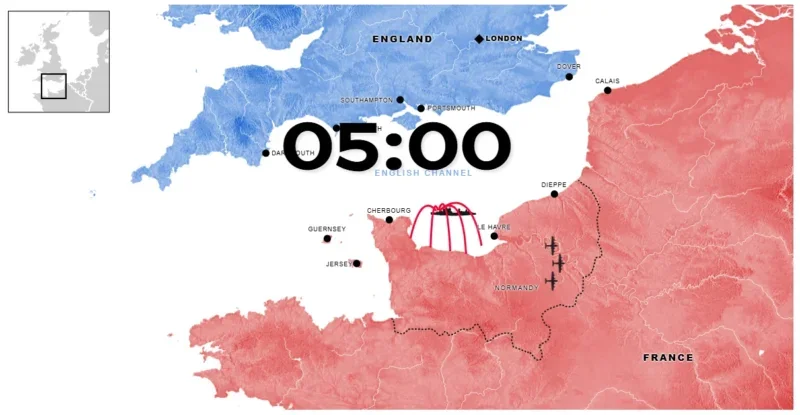
Mail Online may be best known for eye-catching updates on its infamous sidebar of shame but it is also growing its reputation as a home for immersive in-depth reporting via its British Journalism Award-winning Deep Dive online strand.
Mail Online hired senior visual storytelling designer Harry Lewis-Irlam to work on the new format in January 2024.
He has been working alongside Mail Online’s data team, led by associate editor Stephen Matthews, to create pieces like an hour-by-hour visualisation of D-Day, minute-by-minute of the Charlie Hebdo massacre, and an exploration of what could happen if China seized Taiwan.
But it’s not all heavy-hitting topics: another Deep Dive piece used charts to track Leonardo DiCaprio’s age alongside those of his girlfriends over the years.
By the end of the year Deep Dive had won the Innovation of the Year prize at the British Journalism Awards, with judges praising the “genuinely innovative new story format” as a “clever way of conveying complex information without overwhelming the audience”.
Deep Dive is not intended as a revenue-driving part of Mail Online (yet). There are no ads on the pages and they are not paywalled as part of Mail+, which restricts access to a small number of articles on the site each day.
Lewis-Irlam described Deep Dive as “the best of the best that we can do in terms of both journalism storytelling, and visually”.
He pointed out that Mail Online is strong on video, with a major presence on Youtube and Tiktok and vertical video sections on its homepage, but that it had not previously been showcasing the full depth of its journalism on its site.
This interview took place before the Mail told staff of plans to cut a double-digit number of jobs in the final part of its transition into being a “dynamic digital-first newsroom”.

Mail Online Deep Dive ‘above average’ for page views and dwell time
Matthews said that Deep Dive is essentially “refashioning the Mail’s world-beating journalism into something that looks incredible, which only Harry and designers like Harry can do”.
He said the pieces are strong on both dwell time and page views – although how they look at these metrics has changed along the way.
Lewis-Irlam added: “I think there was a point where, when we first launched it, we were very focused on page views – raw numbers of how many people have clicked on this article. But we realised that because it’s so outside of the usual article style for a normal Mail reader, that people would quite often come onto the article and be like, I don’t know what I’m looking at here, and might jump off, but those who actually engage with the content were sticking around for significantly longer than anyone else on any other article. So we started judging it a bit more on dwell than we do on page views now.
“We want to figure out which stories are more engaging than others, and then we can start to focus more on that sort of narrative, creating stories around those things that people are enjoying reading more.”

Matthews said a timeline of how the deadly Grenfell tower fire disaster unfolded got about 30,000 page views but a huge average dwell time of over seven minutes. “It’s almost like someone’s watching video.” Another, about the 7 October 2023 attack by Hamas, had a dwell time of more than five minutes.
In general the aim for a Deep Dive piece is for a dwell time of two-and-a-half or three minutes, compared to Mail Online’s average for a normal story of about 40 seconds. But Deep Dives are also performing highly on page views, at around 60,000 on average.
Opportunity for Mail Online to ‘show off and dispel myth that we’re stuck in our ways’
The vision for Deep Dive came from Mail Online chief executive (then editor and publisher) Danny Groom and global editorial director Ben Bailey. Lewis-Irlam explained that the idea was in part to follow in the footsteps of the visual storytelling being done by broadsheets like the Financial Times and The Telegraph but to put a more tabloid/popular spin on it.
Asked why he thought popular brands like the Mail had taken longer to come out with this visual storytelling approach, Lewis-Irlam suggested that it simply hadn’t needed to and that it may have been “a victim of its own success over the years”.
“It’s been so highly read and the numbers are always so high that they’re not necessarily at all times thinking how can we do something that’s going to be new or innovative… So I think it got to a point where maybe people within the business, and certainly higher up, people were like, well, we want to see more of this stuff. We want to show that we can do these topics and bat with the big boys on this one.”
He added that many of the brands that have invested in visual storytelling skills are subscription-based, which means they need to provide extra value. “You need to be seen to be doing something new and something really impressive to justify people paying that money to stay on your website, to keep paying for your app.
“We haven’t needed that. So this has become more of a glory project. It’s not there to push revenue. It’s not there to push subscribers. It’s not on Mail+. It doesn’t have adverts. It’s just to show off that we can do these things and just maybe dispel the myth that we’re stuck in our ways.”
He suggested that sponsorship by companies could end up being a way some of the pieces can earn money, but added: “Danny and Ben have made it clear that the goal is to produce good journalism.”
Matthews added: “Obviously we’re going to have to make money at some point on it. But for now we’re finding our way.”

Deep Dive pieces come out approximately every two weeks, with articles planned around pegs like anniversaries, but can be more responsive if something crops up that the team feels could benefit from their treatment. The more pieces that come out, the faster each one can be produced and the higher expectations become.
Lewis-Irlam initially worked with the Mail Online tech team to share the vision for Deep Dive pieces and make sure they could work properly across all devices. He largely custom builds the pieces through HTML, with Matthews describing him as being “plugged into the matrix when he works”, meaning little expenditure on tech and software.
Matthews explained that problems can arise because “journalists, speaking on behalf of myself here, tend to have these great visions about how these things look… and then actually they just don’t work. So you have to go back to the drawing board and trust in your designers a bit more. And I think, to begin with, if I’m honest, I didn’t trust Harry because I hadn’t worked with him before.” Now there is a two-way back and forth which starts long before a story is written.
For example, for a piece about how phones stolen in London end up in China, Lewis-Irlam began with the idea for a hand to grab a phone at the top of the page which the reader follows throughout. He shared this vision with editorial who then wrote the copy around the design.
Email pged@pressgazette.co.uk to point out mistakes, provide story tips or send in a letter for publication on our "Letters Page" blog
